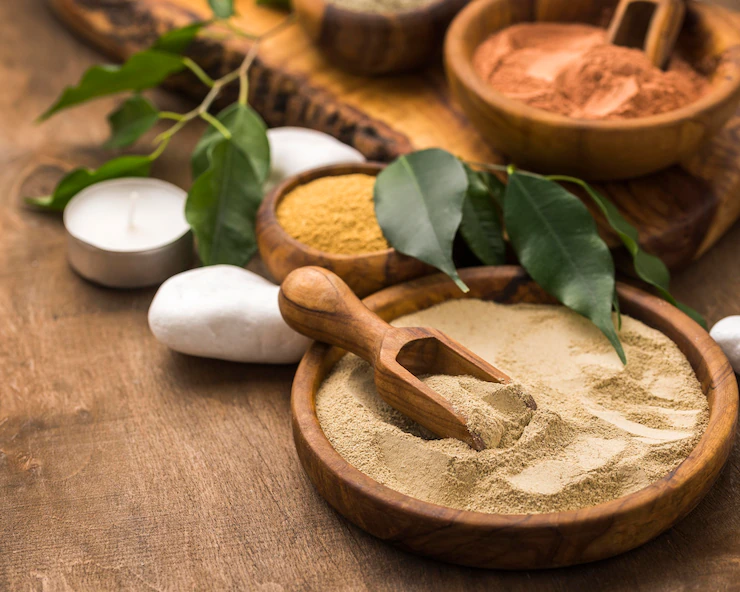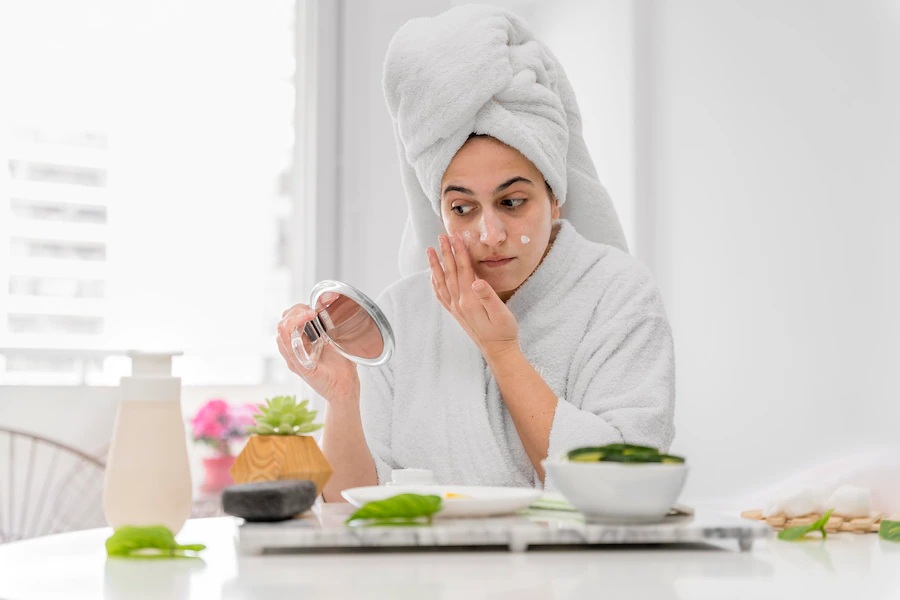Discover The Skin Benefits Of Multani Mitti Clay And Salicylic Acid Face Washes
Multani mitti, also known as Fuller’s Earth, is a magical natural clay that has been used for centuries in Ayurvedic and Indian beauty regimens to care for normal, oily, and sensitive skin. When combined with clarifying ingredients like salicylic acid face washes, Multani mitti provides exceptional oil control, fights acne, evens skin tone, and gives your complexion a natural glow.
This in-depth guide will cover everything you need to know about multani mitti clay masks, soaps, scrubs, and salicylic acid cleansers. Learn about the origins, types, skin benefits, recipe formulas, and usage tips for incorporating multani mitti and salicylic acid into your regular skincare routine. Give your skin the gentle yet effective care it deserves!
Chapter 1: Origins And History Of Multani Mitti

Multani mitti, translated as “mud from Multan,” is a natural clay derived from fuller’s earth, a sedimentary mineral deposit that is mined in the Pakistani town of Multan. Composed mainly of silica, alumina, magnesium, lime, iron oxides, and puzzolana, Multani mitti has powerful oil absorption and exfoliation properties.
References to multani mitti for skin and hair care date all the way back to ancient Indian Ayurvedic healing traditions. Betelnut powder or ash would be mixed with the clay to create a gentle face and body mask. Brahmi or amla powders were often added for additional skin-enhancing benefits.
Traditional Ayurvedic texts praise multani mitti for its ability to cool aggravated skin, fight infections, combat acne, reduce oiliness, minimize the appearance of pores, and leave skin soft and glowing. Multani mitti has remained a mainstay in natural Indian beauty regimens for centuries.
Chapter 2: Modern-Day Skin Benefits Of Multani Mitti
Thanks to multani mitti’s potent medicinal properties and skin-beautifying effects, it has exploded in popularity on the international skincare scene in recent years. Spas and cosmetic companies all over the world now incorporate multani mitti into cleansing masks, creams, soaps, scrubs, and more.
Some of the top ways multani mitti benefits your skin include:
- Absorbing excess oil and sebum – balances oily zones and prevents greasy shine
- Gently exfoliating – removes dead skin cells and product residue
- Minimizing pores – tightens and tones for a refined texture
- Clearing acne – antibacterial and anti-inflammatory properties
- Calming irritation – soothes sensitive or inflamed skin
- Brightening complexion – lightens pigmentation and dark spots
- Adding glow – refines skin tone for a luminous effect
No wonder Multani Mitti has gained superstar status with skincare enthusiasts looking for natural, effective ingredients free of harsh chemicals!
Chapter 3: Different Types And Classifications Of Multani Mitti

While the main source of multani mitti is fuller’s earth clay from Multan, Pakistan, various grades and varieties exist:
Regular Multani Mitti – The most common type, medium-density clay coloring can range from greyish brown to ochre depending on mineral content. Most absorptive. Best general balancing properties for all skin types.
Pink Multani Mitti – Considered the highest quality. Denser clay with a distinct pinkish hue due to the presence of iron oxides. Exceptional cleansing and skin polishing properties. Ideal for oily, acne-prone skin.
Yellow Multani Mitti – Made from an alternative fuller’s earth source higher in lime content, giving it a yellowish tan color. Still highly absorptive but gentler. Best for dry or sensitive skin types.
Red Multani Mitti – Rich in iron oxides with a distinctive red-brown color. Very mild exfoliating and absorbent action. Most suitable for dry, irritated, or aging skin.
When purchasing multani mitti, always look for 100% pure clay powder free of added fragrances, chemicals, or preservatives. Store in an airtight container away from moisture and enjoy the benefits!
Chapter 4: Making Multani Mitti Masks, Facials And Scrubs At Home
One of the best aspects of multani mitti is that it’s very simple and rewarding to use at home. Just mix with water to form a spreadable paste, apply to your face or body, allow it to dry, then rinse away. The clay will work it’s clarifying, soothing magic!
For enhanced benefits, you can easily whip up custom multani mitti recipes tailored to your skin’s needs:
Basic Multani Mitti Mask – Just mix multani mitti powder with enough water, rose water, or yogurt to form a thick paste. Apply to the face avoiding the eye area. Allow to dry for 15 minutes before rinsing.
Skin-Brightening – Combine 2 tbsp multani mitti, 1 tbsp tomato juice, 1 tsp yogurt, and a few drops of lemon juice. Let sit 10-15 minutes before rinsing with warm water.
Anti-Aging – Mix 2 tbsp multani mitti, 1 tsp honey, 1 tbsp aloe vera gel. Apply to face and neck. Rinse after 20 minutes.
Acne-Clearing – Stir together 1 tbsp multani mitti, 1 tsp lime juice, pinch of turmeric. Apply to problem areas and let dry completely before rinsing.
Exfoliating Scrub – Mix 1 tbsp multani mitti, 1 tsp rose water, pinch of sea salt. Gently massage over damp skin in circular motions before rinsing.
So simple yet so effective! Be sure to patch-test any new ingredients first. Store leftover dry masks in the fridge for up to four days.
Chapter 5: Using Multani Mitti Soap For Face And Body
In addition to masks and scrubs, multani mitti can be found in a variety of skin cleansing products like soaps, cleansers, and face washes. Multani mitti soaps provide thorough pore purification without stripping the skin:
- Gently exfoliate and polish away dead skin cells.
- Draw out impurities in clogged pores to prevent acne.
- Control excess oil and sebum production.
- Improve skin texture and tone for smooth radiance.
- Require no lengthy mask drying time – just lather, massage, and rinse!
When shopping for multani mitti soap, look for natural blends free of sulfates, parabens, artificial fragrances, and preservatives. Avoiding harsh detergents prevents dryness or irritation. Using a multani mitti cleansing bar daily provides a deep clean while leaving skin fresh, balanced, and healthy-looking.
Chapter 6: Origins And Usage Of Salicylic Acid In Skincare
Now that we’ve covered this Ayurvedic clay in depth, let’s explore how salicylic acid perfectly complements multani mitts’ clarifying and acne-fighting properties.
Salicylic acid is a beta-hydroxy acid derived from the bark of the willow tree. It works as a keratolytic agent, meaning it dissolves keratin, the protein that makes up your skin and hair. This allows dead skin cells to shed more rapidly.
Salicylic acid was first isolated from willow bark extract in 1838 by Henri Leroux, a French pharmacist. He named it after Salix alba, the scientific name for white willow trees. Salicylic acid soon became widely used for many medicinal purposes.
In the 1990s, dermatologists began incorporating salicylic acid face wash into acne treatments and skincare formulas. Today salicylic acid cleansers, scrubs, moisturizers, and spot treatments remain popular for combating breakouts and promoting clearer skin.
Chapter 7: The Skin Benefits Of Salicylic Acid
Here’s a closer look at the many ways salicylic acid improves skin health:
- Exfoliates inside pores – sloughs off dead cells to prevent clogged pores.
- Dissolves oil and sebum – clears away the acne-causing buildup.
- Reduces acne inflammation – calms redness and swelling.
- Prevents future breakouts – stops acne-causing bacteria.
- Refines texture – smooths roughness and bumps.
- Removes dead skin – helps other products absorb better.
- Balances oily zones – controls shine on the t-zone and nose.
- Improves ceramide production – helps strengthen the skin barrier.
No wonder salicylic acid is a skincare superstar for keeping congestion and breakouts at bay without over-drying like harsh ingredients can.
Chapter 8: Choosing The Best Salicylic Acid Cleansers And Face Washes

When shopping for a salicylic acid face wash, look for the following ideal qualities:
- 2% salicylic acid concentration – provides acne-fighting benefits without irritation.
- Creamy, gentle formula – look for hydrating glycerin, fatty alcohols, and hyaluronic acid.
- Free of fragrance/dyes – avoid further irritating sensitive skin.
- Non-comedogenic – won’t clog pores and worsen breakouts.
- Daily use – gentle enough for consistent AM/PM cleansing.
- Dispenses as a creamy gel – spreads easily and rinses clean.
Some of my top salicylic acid cleanser picks contain acne-fighting ingredients like sulfur, niacinamide, or tea tree oil in addition to 2% salicylic acid. Using a treatment face wash with optimal anti-acne ingredients keeps breakouts at bay without compromising your skin’s moisture barrier.
Chapter 9: Tips For Using Salicylic Acid Face Wash
To get the most out of your salicylic acid cleanser, follow these tips:
- Massage into damp skin for 60 seconds – don’t rush, allow it to work!
- Rinse thoroughly – wash away all residue after cleansing.
- Follow with lightweight moisturizer – counteract potential dryness.
- Use morning and evening – consistency is key.
- Limit to once daily if dryness occurs – reduce frequency.
- Apply a pea-sized amount – a little goes a long way.
- Watch for increased irritation or peeling – adjust usage as needed.
With consistent use of the right formula, a salicylic acid face wash can radically improve acne-prone skin. Be patient, as it takes 4-6 weeks of daily cleansing to see full effects. You’ll be rewarded with clear, glowing skin!
Chapter 10: Making Salicylic Acid Exfoliating Scrubs At Home
In addition to cleansers, you can easily whip up exfoliating salicylic acid scrub recipes at home using items from your pantry:
- Combine 1 tsp salicylic acid powder, 1 tbsp honey, 1 tbsp milk or yogurt, and 1 tsp aloe vera gel. Apply to damp skin, massaging gently before rinsing.
- Mix 2 tsp salicylic acid powder, 3 tbsp rice flour, 1 tbsp rose water or witch hazel, and 3 drops of tea tree oil. Smooth over the face using circular motions to exfoliate.
- Stir 1 tsp salicylic acid powder into 2 tbsp plain Greek yogurt with a pinch of turmeric powder. Spread onto acne-prone zones. Allow to sit for 5 minutes before rinsing.
Be sure to start by patch-testing any new ingredients. Use salicylic acid facial scrubs no more than 2-3 times per week to avoid over-exfoliating. Your skin will feel refreshed and renewed!
Chapter 11: Combining Multani Mitti And Salicylic Acid For Clear Skin
Now that you’re a pro on multani mitti clay and salicylic acid separately, let’s discuss using them together for enhanced clearing and brightening facial masks:
Asian Beauty Mask: Combine 1 tbsp multani mitti powder, 1 tsp salicylic acid powder, 1 tbsp rice flour, and 1 tbsp yogurt. Let sit on the skin for 15-20 minutes before rinsing.
Acne Clearing Mask: Mix 1 tbsp multani mitti, 1 tbsp bentonite clay, 1 tsp salicylic acid powder, and enough rose water to form a spreadable paste. Leave on acne-prone areas for 10 minutes.
Skin Clarifying Mask: Stir together 1 tbsp multani mitti, 1⁄2 tsp salicylic acid powder, 1⁄2 tsp turmeric powder, and 1 tsp raw honey. Apply a smooth paste over the face and neck, excluding the eye area. Allow to dry for 10 minutes before rinsing with lukewarm water.
Use these powerful ingredient duos up to twice weekly for clean, balanced, even-toned skin. Scale back if any dryness or irritation occurs.








